Initially, the Right of Children to Free and Compulsory Education (RTE) Act, 2009, was widely welcomed as overdue legislation to universalise elementary education. Eight years after it became law on April 1, 2010, it’s becoming increasingly clear that the Act has severely damaged Indian education - Dilip Thakore
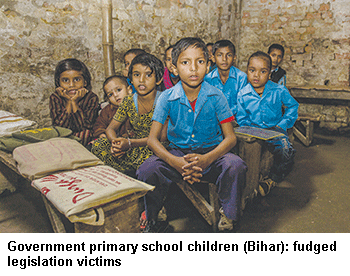 ON THE EVE OF THE EIGHTH anniversary of the historic Right of Children to Free & Compulsory Education Act, 2009 (aka RTE Act) which became operational law on April 1, 2010, a rising swell of protest is brewing against its several iniquitous provisions, which are eroding the fragile foundations of post-independence India’s continuously neglected primary/elementary education system.
ON THE EVE OF THE EIGHTH anniversary of the historic Right of Children to Free & Compulsory Education Act, 2009 (aka RTE Act) which became operational law on April 1, 2010, a rising swell of protest is brewing against its several iniquitous provisions, which are eroding the fragile foundations of post-independence India’s continuously neglected primary/elementary education system.
Initially, the RTE Act legislated by the Congress-led UPA-II government shortly after it was returned to office at the Centre for a second consecutive term in 2009, was widely welcomed and received the support of Parliament, academia and the intelligentsia. The common understanding of this overdue legislation (made a fundamental right on a par with the Right to Life by inserting Article 21-A into the Constitution), was that it made it mandatory for the State (i.e, the Central, state and local governments) to provide free and compulsory elementary (class I-VIII) education to all children in the 6-14 age group. The reality that this belated enactment fudged the directive (Article 45) of the founding fathers of the Constitution of India to provide free and compulsory pre-primary and elementary education to all children in the 0-14 age group within ten years of the promulgation of the Constitution, i.e 1960, was glossed over with the popular sentiment being that even if belatedly, the Congress party — which has ruled at the Centre and most of India’s state capitals for over 50 years — had at least partially discharged its constitutional obligation.
Fudging responsibility of the State (i.e, government) to also provide free and compulsory early childhood care and education in the 0-6 age group was the handiwork of silver-tongued heavyweight Supreme Court lawyer Kapil Sibal, appointed Union minister of human resource development i.e, education, of the UPA-II government who drafted and piloted the RTE Act through Parliament in 2009. This sin of omission was compounded by insertion of s.12 (1) (c) into the RTE Act which partially offloaded the obligation of the State — bankrupted by successive Congress governments and the Nehru-Indira dynasty (whose heirs and successors still lead the party) in particular — upon the country’s estimated 320,000 ‘recognised’ private schools which host almost half of the 250 million children enrolled in school at the start of every academic year. Under s. 12 (1) (c), private schools are obliged to reserve 25 percent capacity in class I for children from poor households in their neighbourhood, and provide them free-of-charge education until they complete class VIII.
This provision which not only side-stepped the State’s responsibility to provide children in the 0-6 age group early childhood care and education but also partially offloaded its obligation to provide free-of-charge elementary education to children in the 6-14 age group was nevertheless welcomed by the academy and intelligentsia dominated by overt and covert Marxists and socialists. These cheerleaders of the Congress and communist parties have dutifully supported the Nehru-Gandhi dynasty’s disastrous Soviet-inspired economic experiments in post-independence India, including suppression of the subcontinent’s ancient private enterprise tradition, neglect of agriculture and education, and canalisation of the savings of the population into giant capital-intensive, non-performing public sector enterprises which have ruined industry and the economy.
It’s instructive to recall that at the end of World War II, several well-established private sector business houses, including Tatas, Birlas, Walchand Hirachand, Shri Ram and Kasturbhai Lalbhai, among others were poised to resurrect Indian industry and re-discover India’s rich pre-colonial heritage of free enterprise and free markets and establish this country as a role model of the newly-liberated countries of the post-colonial third world. But enthusiastically supported by the left-dominated academy and intelligentsia, the Congress party under the country’s first prime minister Jawaharlal Nehru, led the nation down the disastrous socialist road, bankrupting free India.
Unsurprisingly covert and overt left intellectuals who continue to dominate the academy, welcomed s.12 (1) (c), reasoning that inclusion of poor children into independent private schools would confer the benefit of class heterogeneity upon these exclusive preserves of the middle and upper classes. Moreover, left-liberal champions of the RTE Act derived satisfaction from s. 12 (2) of the Act which provides for partial reimbursement to private schools admitting poor children in their neighbourhood in classes I-VIII. It directs state governments to pay the average per-student cost incurred by them in government elementary schools.
Curiously, this provision — s. 12 (1) (c) — partially offloading the State’s obligation to provide universal primary education upon private, independently-financed schools, was validated by the Supreme Court. Objective legal experts trace the Supreme Court’s laboured 2-1 majority judgement in Society for Unaided Private Schools of Rajasthan vs. Union of India (2010) back to the 1970s when prime minister Indira Gandhi (Nehru’s daughter) packed the apex court with “committed”, i.e, socialist/leftist judges. During that tumultuous decade when Mrs. Gandhi nationalised the country’s 28 major banks, the coal industry and even the foodgrains trade for a while, culminating in the country’s first and as yet only internal Emergency (under Article 352 of the Constitution) imprisoning leaders of all major opposition parties and imposed press censorship, committed judges of the apex court passed a rash of judgements upholding heavy-handed government regulation and prohibiting “commercialisation of education”, particularly in privately promoted institutions of professional education. Under the norms of the country’s common law judicial system, these apex court judgments have become binding legal precedents and established law.
Therefore even after the Congress party under its first non-Nehru-Indira dynasty prime minister Narasimha Rao, acknowledged the bankruptcy of post-independence India’s Soviet-inspired economic development model and substantially liberalised and deregulated the Indian economy in 1991, freeing it from decades of licence-permit-quota raj, bound by the laws of precedent, in the Society for Unaided Private Schools of Rajasthan case, the Supreme Court upheld s.12 (1) (c). But it magnanimously exempted minority and boarding schools from the ambit of the section. However this exemption of minority schools from the purview of s. 12 (1) (c) has since provoked a flood of litigation over the definition of minority institutions.
Inevitably, s. 12 (1) (c) is not the only provision of this hastily drafted Act which opened a Pandora’s box of evils further debilitating post-independence India’s crumbling primary/elementary education system. Under s. 16, promotion of children to the next class annually is automatic until class VIII (“no child admitted in a school shall be held back in any class or expelled from school till the completion of elementary education”). This liberal 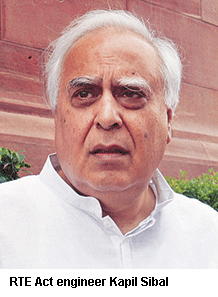 provision has had the devastating impact of diluting academic standards in primary schools countrywide.
provision has had the devastating impact of diluting academic standards in primary schools countrywide.
Eight years after the RTE Act became law, informed educationists are now almost unanimous that this pernicious provision has disincentivised children from learning and teachers from teaching diligently. The adverse impact of s.16 in primary education has been tracked and confirmed by the Annual Status of Education Report (ASER) published by the highly-reputed Mumbai/Delhi-based Pratham Education Foundation. Every year Pratham’s army of 20,000-plus volunteers administer field tests to thousands of children in over 550 districts of rural India to measure their actual learning outcomes. ASER surveys have been repeatedly warning — to little avail — that the percentage of children in higher primary classes (V-VIII ) who cannot read class II and III textbooks and/or do 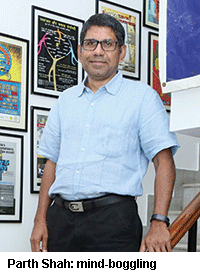 simple arithmetic sums, is rising and has crossed 50 percent.
simple arithmetic sums, is rising and has crossed 50 percent.
Apart from s. 12 (1) (c) and s. 16, there are other provisions of the RTE Act which — it’s now very clear — have seriously damaged the country’s vitally important elementary education system. S. 19 of the Act prescribes several infrastructure and teacher-pupil ratio norms for private schools, failure to adhere to which permits state governments to levy heavy fines on promoters and/or force their closure. However, iniquitously, the infrastructure, teacher-pupil ratio and other norms prescribed by s. 19 are not applicable to the country’s 1.20 million government schools in which the majority of India’s 250 million children receive rock-bottom primary/elementary education.
This section of the Act has hit the country’s unique budget private schools (BPS) — low-fee, for-profit primaries established over the past several decades by private sector education ‘edupreneurs’ to provide elementary education — particularly hard. Unable to meet the infrastructure and other norms prescribed by s. 19, an estimated 23,000 BPS across the country have downed shutters, pushing children from low-income aspirational households back into dysfunctional government schools defined by crumbling buildings, multi-grade classrooms, chronic teacher absenteeism and aversion to teaching English — the link language of India and the language of the courts and business.
Sustained discrimination against BPS — many of them ‘recognised’ and operational for decades — during the past eight years under the provisions of s.19 and tardy reimbursement under s. 12 (2) of even the “crookedly calculated” tuition fees of RTE quota children, prompted the emergence of a formidable organisation christened the National Independent Schools Alliance (NISA, estb.2011). The objective of NISA is to provide private schools, especially BPS institutions a “unified voice to address their concerns about legislations and bye-laws which apply to them and to facilitate quality improvement in schools”.
Since then over the past seven years, this alliance led by BPS institutions, which although they fulfil a legitimate social need, has aroused the hatred, ridicule and contempt of the neta-babu brotherhood and left intellectuals who dominate the academy, has grown impressively.
Currently NISA claims a membership of 55,400 schools from 20 state-level associations with an aggregate enrolment of 9.35 million children across the country. However the growth potential of NISA is mind-boggling. According to Dr. Parth Shah, a former professor of economics at Michigan University and founder-president of the Centre for Civil Society (estb. 1997) — one of India’s top-ranked (by the Lauder Institute of Pennsylvania University) think tanks — the total number of BPS across the country is a massive 450,000 with an estimated enrolment of 60 million children. In 2011 on behalf of CCS, Shah signed a PACT (progressive action commitments treaty) to undertake “advocacy to build a facilitative environment for Budget Private Schools and improve the image of the BPS sector” with a representative delegation of budget private schools, prompting the establishment of NISA.
The patience and forbearance of NISA members having finally snapped on the eve of the eighth anniversary of the RTE Act, this formidable alliance has convened a national rally of leaders, teachers and sympathisers of private schools at Delhi’s Ramlila Grounds on April 7 to demand representation of private schools in education policy formulation councils of the Central and state governments, and particularly to discuss the social cost-benefits of the RTE Act, 2009. Optimism among NISA convenors and leaders that the alliance’s Shiksha Bachao Andolan (‘Save Education Movement’) rally this month will evoke a massive response, is high. According to NISA spokespersons, arrangements have been made to host 100,000 independent school promoters, teachers and supportive parents and sympathisers.
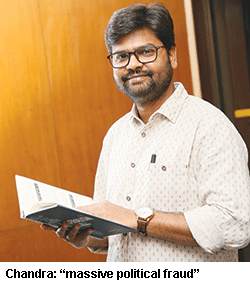 Eight years after it was legislated by Parliament amid great hopes and expectations, it’s now painfully clear that the RTE Act has severely damaged — instead of improving and universalising — elementary education in India. The Act is deeply flawed and indeed fraudulent legislation which is beyond repair and should be scrapped before it totally ruins India’s critically important primary/elementary system,” says Dr. Amit Chandra, national convenor of NISA. An alumnus of the Mahatma Gandhi Krishi Vidyapeeth University, Varanasi with a Ph D in social work, and former associate director of CCS (2007-2017) now working full-time with NISA, Chandra advances several formidable arguments for repealing the RTE Act.
Eight years after it was legislated by Parliament amid great hopes and expectations, it’s now painfully clear that the RTE Act has severely damaged — instead of improving and universalising — elementary education in India. The Act is deeply flawed and indeed fraudulent legislation which is beyond repair and should be scrapped before it totally ruins India’s critically important primary/elementary system,” says Dr. Amit Chandra, national convenor of NISA. An alumnus of the Mahatma Gandhi Krishi Vidyapeeth University, Varanasi with a Ph D in social work, and former associate director of CCS (2007-2017) now working full-time with NISA, Chandra advances several formidable arguments for repealing the RTE Act.
According to Chandra, the RTE Act is “a massive political fraud camouflaged as pro-poor legislation” perpetrated by the Congress party on the people of India. For one, under the Constitution and the Universal Declaration of Human Rights Convention, 1948 of which India is a signatory, provision of free and compulsory education to all children in the 0-14 age group is the sole obligation of government. However, this solemn obligation has been “fudged” and under s.12 (1) (c), a substantial share of this obligation has been passed on to private schools. This original sin has been compounded by fraudulent calculation of the reimbursement formula under which state governments are obliged to reimburse private schools the cost of tuition provided to children admitted into class I and retained until class VIII.
“Under s. 12 (2), governments are obliged to reimburse private schools the per-child expenditure they incur in their own schools. But this is done on the basis of a fraudulent formula which calculates the reimbursable amount on the basis of government schools’ teachers’ salaries divided by number of students. The compensation formula does not take overheads and recurring expenses of government schools into account. If the reimbursable amount is calculated scientifically, the amount payable per child admitted into private schools under s. 12 (1) (c) could be as high as Rs.80,000 per month. And this massive fraud is compounded by the tardy reimbursement of even the fudged reimbursable amount by all state governments,” says Chandra.
The constitutional validity of s. 12 (1) (c) was upheld by a three-judge bench of the Supreme Court by a 2-1 majority verdict delivered on April 12, 2012 (Society for Unaided Private Schools of Rajasthan vs. Union of India & Anr (Writ Petition (C) No. 95 of 2010)) which however exempted boarding and minority schools from applicability of this provision. But according to Chandra, six years after the Supreme Court verdict, it’s clear the majority judgement has complicated elementary education in India and prompted a rash of litigation over the definition of “minority schools”, “neighbourhood”, “poor/underprivileged households” and unleashed the genie of corruption in primary education as it vests wide discretionary powers in local officials to certify poor households and children who should be admitted under s.12 (1) (c). In retrospect, it’s now clearly apparent that the minority judgement of Justice K. S. Radhakrishnan was correct in rejecting the constitutional validity of s. 12 (1) (c) (see box p.48).
The damage inflicted upon the country’s already fragile primary/elementary education system by s.12 (1) (c) apart, Chandra and NISA spokespersons highlight several other serious infirmities of the ill-conceived and recklessly legislated RTE Act, 2009.
Among them: s. 16 which provides for the automatic annual promotion of every child in elementary education until completion of class VIII (“ruined learning outcomes in foundational elementary education”); s. 18 which mandates that no private schools shall be established or function without obtaining a certificate of recognition from government, and s. 19 (1) which prohibits any ‘prescribed authority’, i.e, Central, state or local government from granting recognition to any school until it conforms with the infrastructure, teacher-pupil and other norms listed in a special Schedule of the Act.
Among the norms listed in the Schedule: a playground of at least 1 acre in urban areas and 1.5-2 acres in rural India. Under s. 19 (2), schools which did not fulfil the requirements of the Schedule were given three years to take steps to fulfil the norms failing which they would be derecognised and their managements subject to heavy fines and forced closure. Inexplicably, schools “established, owned or controlled by the appropriate government or local authority” are specifically exempted from applicability of s. 19 and the Schedule.
Although promoters of BPS are disillusioned with several provisions of the populist RTE Act, 2009, recklessly drafted and piloted through Parliament by the Congress party’s quintessential Cadillac communist, legal eagle and then Union HRD minister Kapil Sibal (who after the crushing defeat of the Congress and allied parties in General Election 2014 is back in business as a top-ranked Supreme Court counsel earning Rs.20-30 lakh per day), their special ire is directed at s. 19. They believe it has been specially designed to harass and close down BPS institutions that are posing a direct threat to the country’s 1.20 million failing government schools.
All NISA spokespersons highlight the exemption granted in s. 18 from applicability of s. 19 and Schedule norms to government schools, and reluctance of the State to reimburse even the fraudulently calculated cost per child in government schools to BPS managements. Among BPS and modestly priced private schools, the unholy combination of s. 12 (1) (c), s. 12 (2) and ss. 18-19 are widely interpreted as provisions designed to harass and close down private schools and force children who have escaped government schools, back into them.
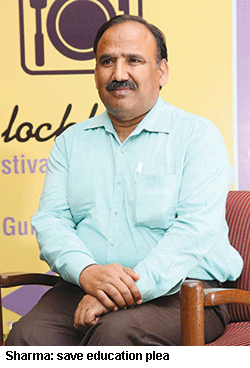 “To ensure universal elementary education for all children in the 6-14 age group — the prime objective of the RTE Act — it is necessary to increase the number of schools. Instead during the past eight years, 23,000 BPS primaries which were providing better education than government schools, have been shut down across the country, and another 20,000 are contemplating shutting down because of continuous harassment by government officials. At the same time because of increasing harassment and widely divergent rules prescribed under the Act by state governments, investment in new private schools is drying up. Therefore considering that almost half of the country’s children are in private schools, this time our demand is beyond amending and/or repealing the RTE Act. Our April 7 Save Education rally’s objectives are much beyond the RTE Act and is an appeal to the public to join with us to save Indian education from the country’s fraudulent and populist politicians who have divided the academic community into government versus private. Moreover, our agitation is not only of BPS schools. We have the support of all independent schools which have made common cause with us through their representative associations,” says Kulbhushan Sharma, president of NISA and the newly formed Coalition for School Education. A relentless critic of the RTE Act ab initio, Sharma is a commerce graduate of Panjab University and promoter of the class I-VIII SDM Model School, Ambala (estb. 1989) which has an enrolment of 480 pupils.
“To ensure universal elementary education for all children in the 6-14 age group — the prime objective of the RTE Act — it is necessary to increase the number of schools. Instead during the past eight years, 23,000 BPS primaries which were providing better education than government schools, have been shut down across the country, and another 20,000 are contemplating shutting down because of continuous harassment by government officials. At the same time because of increasing harassment and widely divergent rules prescribed under the Act by state governments, investment in new private schools is drying up. Therefore considering that almost half of the country’s children are in private schools, this time our demand is beyond amending and/or repealing the RTE Act. Our April 7 Save Education rally’s objectives are much beyond the RTE Act and is an appeal to the public to join with us to save Indian education from the country’s fraudulent and populist politicians who have divided the academic community into government versus private. Moreover, our agitation is not only of BPS schools. We have the support of all independent schools which have made common cause with us through their representative associations,” says Kulbhushan Sharma, president of NISA and the newly formed Coalition for School Education. A relentless critic of the RTE Act ab initio, Sharma is a commerce graduate of Panjab University and promoter of the class I-VIII SDM Model School, Ambala (estb. 1989) which has an enrolment of 480 pupils.
In this connection, it’s important to note that contrary to government and comfy left academics’ propaganda, NISA’s Save Education campaign is not being driven by shady promoters of slummy, ‘unrecognised’ BPS schools intent upon making a quick buck. The greater proportion of them are bona fide education providers, intent on combining altruism with business and providing children from aspirational lower middle class households half-decent education — including English language learning — which would enable them to rise above their parents’ station in life.
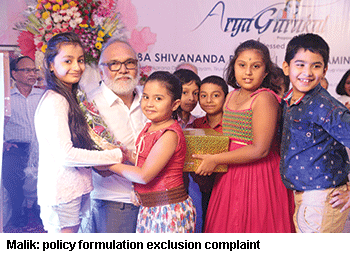 For instance, Bharat Malik is a printing technology and advertising alum of the Bharatiya Vidya Bhavan, Mumbai and promoter of the class I-X St. Mary’s High School, Kalyan in suburban Mumbai, ranked India’s #2 and Maharashtra’s #1 BPS in the EducationWorld India School Rankings 2017-18, and of five Arya Gurukul primary schools and eight pre-primaries. All of them are government recognised institutions and boast an aggregate enrolment of 6,000 boy and girl pupils. However, none of them are wholly compliant with the infrastructure norms prescribed by s. 19 and the Schedule of the RTE Act, 2009.
For instance, Bharat Malik is a printing technology and advertising alum of the Bharatiya Vidya Bhavan, Mumbai and promoter of the class I-X St. Mary’s High School, Kalyan in suburban Mumbai, ranked India’s #2 and Maharashtra’s #1 BPS in the EducationWorld India School Rankings 2017-18, and of five Arya Gurukul primary schools and eight pre-primaries. All of them are government recognised institutions and boast an aggregate enrolment of 6,000 boy and girl pupils. However, none of them are wholly compliant with the infrastructure norms prescribed by s. 19 and the Schedule of the RTE Act, 2009.
“A glaring injustice of India’s education system is that despite the fact that almost 50 percent of the country’s school-going children are in private schools, our representatives are never involved in the policy formulation process. If we were involved in framing the RTE Act, it would never have contained its iniquitous provisions targeting budget private schools which are affordable alternatives for children fleeing dysfunctional government schools. Instead of universalising elementary education, the Act has pushed children out of the system by withholding the reimbursements of BPS and forcing the closure of over 23,000 affordable private schools across the country under s. 19. Therefore the demands of NISA go beyond repeal of the RTE Act. Our goal is greater autonomy for private schools, ease of promoting new schools and recognition based on learning outcomes instead of infrastructure. We are also demanding establishment of a School Finance Corporation to disburse soft loans to for-profit and non-profit schools to upgrade their infrastructure,” says Malik, an activist founding member of NISA.
Typically, left intellectuals who dominate the academy have maintained a deafening silence on the patent iniquities of the RTE Act and blatant persecution of BPS by venal government school inspectors. For instance, Dr. Krishna Kumar, hitherto professor of education at Delhi University and former director of NCERT (National Council of Educational Research & Training), believes that the RTE Act should “not be amended in any manner for a while (because) it has been around for less than a decade”. “This is hardly enough for a complex and bold social policy law to reveal the dimensions on which it might need improvement. As for repealing, if such a thing happens, it will be a horribly retrograde step,” he warns.
With government-run public sector enterprises including companies and banks collapsing across the country, and learning outcomes in government primaries and universities touching record lows, dispassionate monitors of 21st century India’s Dickensian education system have seen the light. Among them is Dr. Geeta Gandhi Kingdon, chair of education economics and international development at the UCL Institute of Education, University College London and president of the City Montessori School, Lucknow (estb.1959), certified by Guinness World Records as the world’s largest single-city school (55,000 students in 18 campuses) and ranked the # 1 co-ed day school of Uttar Pradesh (pop. 215 million) in the EW India School Rankings 2017-18.
In a forthright op-ed page essay written on the eve of the eighth anniversary of the RTE Act for the Times of India (March 13), Kingdon fired a devastating broadside at the Act describing it as “a disastrous experiment” which has “deprived millions of children of their right to education by closing down schools”.
In the 1,000-word essay, which is recommended reading for all right-thinking citizens concerned about the bleak future that awaits the world’s largest national population of children and youth, until and unless India’s bankrupt 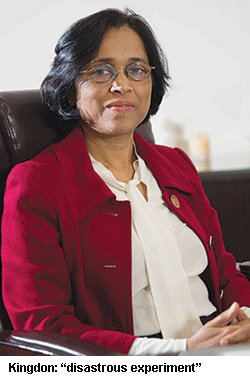 education system is reformed root and branch, Kingdon (a frequent essayist of EducationWorld) singles out ss. 12, 18 and 19 of the Act for withering criticism.
education system is reformed root and branch, Kingdon (a frequent essayist of EducationWorld) singles out ss. 12, 18 and 19 of the Act for withering criticism.
According to her, s. 12 (1) (c) has “accelerated the pre-existent trend of the emptying of government schools, embarrassing state governments”. “In 2015-16, Rajasthan, Maharashtra and Chhattisgarh alone closed about 24,000 government schools where total school enrolment had fallen below ten students” she writes. Also targeting ss. 18-19 which are forcing the closure of “low-fee schools serving the poor and lower middle classes”, Kingdon argues that the (infrastructure) inputs-focussed approach has been “discredited internationally in hundreds of studies and meta-analyses... and international and even national data show that raw learning levels of children in these (BPS) schools are twice (in some states thrice) as high as in government schools”.
Kingdon believes the RTE Act is “premised on mistaken hunch-driven diagnoses” and has “prescribed the wrong (inputs-based) remedies”. She forthrightly recommends that the New Education Policy, which is reportedly in the final stages of completion under the chairmanship of renowned space scientist Dr. K. Kasturirangan (after the comprehensive, 217-page report of a New Education Policy 2016 committee chaired by the late T.S.R Subramanian was rejected and classified as an “input” by Union HRD minister Prakash Javadekar), “must boldly recommend the scrapping of the harmful Right to Education Act, 2009, and suggest policies based on national and international evidence on what has worked to improve children’s outcomes rather than ideology or experimentation”. “The stakes are high for crores of Indian children, and for the country’s growth and prosperity,” she writes.
Contrary to the assertion of left ideology-driven establishment academics and monitors of the national education scene, eight years is a sufficiently long period to assess the on-the-ground impact of the RTE Act, 2009. And the overwhelming weight of evidence is that it has done more harm than good to Indian education.
Eight years after the RTE Act was initially widely welcomed and given prolonged trial, it’s patently clear that it has failed to achieve its stated objectives and threatens to destroy the country’s relatively successful private education school system. Therefore, it needs to be repealed forthwith with its best features, if any, incorporated in the imminent New Education Policy. Indeed the national interest and the future of the world’s largest national child population demands it.
|
Vital provisions of RTE Act, 2009
s.2 (n). “School” means any recognised school imparting elementary education and includes: (iii) school belonging to specified category and (iv) an unaided school not receiving any kind of aid or grants to meet its expenses from the appropriate government or local authority.
s.3 (1). Every child of the age of six to fourteen years shall have a right to free and compulsory education in a neighbourhood school till completion of elementary education.
(2) For the purpose of sub-section (1), no child shall be liable to pay any kind of fee or charges or expenses which may prevent him or her from pursuing and completing elementary education.
s.7 (1). The Central government and the state governments shall have concurrent responsibility for providing funds for carrying out the provisions of this Act.
s.8 (a). The appropriate government shall provide free and compulsory elementary education to every child…
s.12 (1) (c). For the purposes of this Act, a school specified in sub-clauses (iii) and (iv) of clause (n) of section 2 shall admit in class I, to the extent of at least 25 percent of the strength of that class, children belonging to weaker sections and disadvantaged groups in the neighbourhood and provide free and compulsory elementary education till its completion… Provided further that where a school specified in clause (n) of s.2 imparts pre-school education, clauses (a) to (c) shall apply for admission to such pre-school admission.
s. 12 (2). The school specified in sub-clause (iv) of clause (n) of section 2 providing free and compulsory elementary education as specified in clause (c) of sub-section (1) shall be reimbursed expenditure so incurred by it to the extent of per-child-expenditure incurred by the State, or the actual amount charged from the child, whichever is less, in such manner as may be prescribed.
s.16. No child admitted in a school shall be held back in any class or expelled from school till the completion of elementary education.
s.18 (1). No school, other than a school established, owned or controlled by the appropriate government or the local authority, shall, after the commencement of this Act, be established or function, without obtaining a certificate of recognition from the prescribed authority.
s.19 (1). No school shall be established, or recognised, under section 18, unless it fulfils the norms and standards specified in the Schedule.
(2) Where a school established before the commencement of this Act does not fulfil the norms and standards specified in the Schedule, it shall take steps to fulfil such norms and standards at its own expenses, within a period of three years from the date of such commencement.
(5) Any person who continues to run an unrecognised school, shall be liable to fine of Rs.1 lakh and Rs.10,000 per day of contravention.
s.20. The Central government may, by notification, amend the Schedule by adding to, or omitting therefrom, any norms and standards.
s.28. No teacher shall engage himself or herself in private tuition or private teaching activity.
s.37. No suit or other legal proceeding shall lie against the Central government, the state government, the National Commission for Protection of Child Rights, the State Commission for Protection of Child Rights, the local authority, the School Management Committee or any person, in respect of anything which is in good faith done or intended to be done, in pursuance of this Act, or any rules or order made thereunder.
|
|
NISA Charter of Demands
The National Independent Schools Alliance (NISA, estb.2007), a coalition of India’s budget private schools, has convened a massive Save Education Rally at Delhi’s Ramlila Ground on April 7. At the rally, the alliance will present a charter of demands to prime minister Narendra Modi as under.
Autonomy for schools. Schools should have full autonomy to set their work timings, tuition fee, teachers’ remuneration, curriculum, infrastructure facilities etc. The decision to promote children to higher classes should be of the school, not State.
Ease of starting new schools. Depending upon location and level (primary, secondary, senior secondary) 15-36 permissions (certificates, approval, documents) are required by state governments and/or local authorities. It’s high time for a single window clearance system at all levels in Indian education.
Outcomes-based regulation. Currently, government regulation of school education is highly inputs driven, i.e, focused on infrastructure, teacher salaries, compliance with norms stipulated under s.19 of the RTE Act, 2009, and the Schedule thereof. This has led to closure of an estimated 100,000 primary schools across the country. There is urgent national need to switch to a system of regulating public and private schools according to learning outcomes.
Recognition of schools and choice of exam boards. Rules framed by state governments under the RTE Act require recognised private schools to renew their recognition certificates every three years. This adds an unnecessary burden on schools and creates opportunities for bureaucratic corruption. After a school is recognised, its management should be free to choose its exam board (state, CBSE, CISCE etc). Moreover exam boards should not be permitted to set affiliation conditions and their role should be restricted to setting syllabuses, recommending/prescribing textbooks, conducting examinations and research to improve the quality of education.
Choice to be profit or non-profit. Following the deregulation of industry and the economy after 1991, the national interest will be better served by liberalisation and deregulation of education as well. Promoters of education institutions, including schools, should have the option to promote for-profit or not-for-profit institutions.
Fund students, not schools. Funding students rather than schools through direct grants or school choice vouchers will prompt healthy competition between schools to attract and retain students. Competition will improve the quality of schools and K-12 education in general.
Third-party assessment. Independent third-party assessment of children’s learning outcomes data which provides important clues for higher level policy decisions as well as classroom level education delivery strategies, should be encouraged. The scope of the National Achievement Survey (NAS) can be expanded to cover all schools and all children enrolled therein to facilitate third-party assessment.
Separate education regulation, finance and delivery. Currently, government discharges the roles of regulator, financier and provider of education simultaneously. These three roles should be separated and handled by separate entities.
Place education data in public domain. Education data collected by the Central and state governments and their agencies should be presented in time to enable citizens to become involved in debates on education policies and formulation. Such data will also enable parents to choose suitable schools for their children and demand accountability from them.
Mandate TET before B.Ed. The RTE Act exempts government school teachers already in employment before commencement of the Act (2010) from clearing the Teacher Eligibility Test (TET). However, it provides a five-year window for private school teachers to pass TET. This discrimination is unfair and unwarranted.
Moreover, we recommend that TET should be cleared before — not after — teachers are admitted into the postgraduate B.Ed programme.
Establish School Finance Corporation. NISA recommends the establishment of a School Finance Corporation to provide low interest loans to state and local governments and private edupreneurs to construct new schools and/or improve the infrastructure of operational recognised and unrecognised schools, to enable them to become compliant with RTE Act specifications and norms.
|
|
Thus spake Justice Radhakrishnan
 Six years after a three-judge bench of the Supreme Court by a 2-1 majority in Society for Unaided Private Schools of Rajasthan vs. Union of India & Anr (Writ petition (C) No. 95 of 2010) upheld the constitutional validity of s. 12 (1) (c) of the RTE Act, 2009, the flood of litigation provoked by s. 12 (1) (c) has made it abundantly clear that the minority judgement of Justice K.S. Radhakrishnan striking down the impugned section, was the more correct interpretation of law. Excerpts from Justice Radhakrishnan’s minority judgement are given below. Six years after a three-judge bench of the Supreme Court by a 2-1 majority in Society for Unaided Private Schools of Rajasthan vs. Union of India & Anr (Writ petition (C) No. 95 of 2010) upheld the constitutional validity of s. 12 (1) (c) of the RTE Act, 2009, the flood of litigation provoked by s. 12 (1) (c) has made it abundantly clear that the minority judgement of Justice K.S. Radhakrishnan striking down the impugned section, was the more correct interpretation of law. Excerpts from Justice Radhakrishnan’s minority judgement are given below.
The verdict of an 11-judge bench of the Supreme Court in T.M.A Pai Foundation vs. Union of India (2002), which ruled that privately promoted colleges of professional education have a fundamental right to freely and transparently admit students on merit and levy reasonable fees, is applicable to all education institutions. “Further it was ordered (by the T.M.A Pai Foundation judgement) that the expression ‘education’ in all the Articles of the Constitution would mean and include education at all levels, from primary education level to postgraduate level and the expression ‘educational institutions’ would mean institutions that impart education as understood in the Constitution” (para 21).
Compelling cross-subsidisation of students is prohibited. “Casting burden on other students to pay for the education of others was also disapproved by the Pai Foundation (judgement), holding there should be no subsidy” (p. 22).
The State cannot offload any responsibility to provide elementary education to private educators. “Pai Foundation (judgement) was pronounced on 31.10. 2002 (and) 25.11.2002. Article 21A, new Article 45 and Article 51A(k) were inserted into the Constitution on 12.12.2002… Parliament it may be noted, was presumed to be aware of the judgement in Pai Foundation, and no obligation was cast on unaided private institutions, but only on the State, while inserting Article 21A” (p.25).
The judgement of a seven-judge bench of the Supreme Court in Inamdar vs. State of Maharashtra (2005) upheld the verdict of T.M.A Pai Foundation case. “Inamdar (judgement) held that to admit students being one of the components of the right to establish and administer an institution, the State cannot interfere therewith and up to the level of undergraduate admission (and) minority unaided educational institutions enjoy total freedom” (p.29).
Apex court judgements in T.M.A Pai and Inamdar writ petitions are unaffected by Article 21-A which made elementary education for all children in the age group 6-14 compulsory (86th Amendment). “We have to give due respect to the 11 judges in Pai Foundation and the seven judges judgement in Inamdar. The principles laid down in those judgements still hold good and are not whittled down by Article 21A” (p.83).
Free and compulsory elementary education provision solely State responsibility. “The State cannot free itself from obligations under Article 21A by offloading or outsourcing its obligation to private non-State actors like unaided private educational institutions or coerce them to act on the State’s dictate” (p.96).
Article 21-A clear and unambiguous. “Article 21-A has used the expression “the State shall provide” and not “provide for”. Hence the constitutional obligation to provide education is on the State, not on non-state actors. The expression is clear and unambiguous (p.101)… Article 21 read with 21A, therefore casts an obligation on the State and State alone” (p.103).
(Excerpts from the dissenting judgement in Society for Unaided Schools of Rajasthan vs. Union of India & Anr (Writ petition (C) No. 95 of 2010)
|